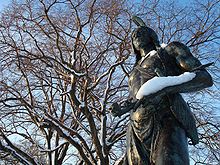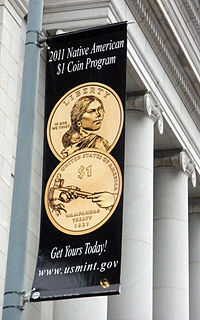- Massasoit
-
 This 1902 photo shows Profile Rock in Assonet, Massachusetts. The local Wampanoag believe it to be the image of Massasoit.
This 1902 photo shows Profile Rock in Assonet, Massachusetts. The local Wampanoag believe it to be the image of Massasoit.
Massasoit Sachem or Ousamequin (c. 1581 – 1661),[1] was the sachem, or leader, of the Pokanoket, and "Massasoit" of the Wampanoag Confederacy. The term Massasoit means Great Sachem.[2]
Contents
Early years
Massasoit (Ousamequin) was born in Montaup, a Pokanoket village at the site of today's Warren and Bristol, Rhode Island.[1] His residence was there near an abundant spring of water which still bears his name.[3] He held the allegiance of seven lesser Wampanoag sachems. In March 1621, three months after the founding of Plymouth, an Abenaki named Samoset entered the town and exclaimed in English — which he had learned from the Penobscot fishermen and from the English fishermen that came to fish off Monhegan Island — “Welcome, Englishmen!” He announced himself as the envoy of Massasoit, “the greatest commander of the country.” After some negotiation, Massasoit came in person and was received with due ceremony.[3]
Massasoit negotiated a treaty guaranteeing the English their security in exchange for their alliance against the Narragansett. Both parties promised to abstain from mutual injuries, and to deliver offenders; the colonists were to receive assistance if attacked, to render it if Massasoit should be unjustly assailed.[3] Massasoit actively sought the alliance since two significant outbreaks of smallpox brought by the English had devastated the Wampanoag during the previous six years. The treaty included the confederates of the sachem, and was sacredly kept for Massasoit's lifetime.[3]
He was commonly known as Massasoit, but he was called by many other names, including: Ousamequin, Woosamequin, Asuhmequin, Oosamequen, Osamekin, Owsamequin, Owsamequine, and Ussamequen.[1]
Forging peace
According to English sources, Massasoit prevented the failure of Plymouth Colony and the almost certain starvation that the Pilgrims faced during the earliest years of the colony's establishment. Moreover, Massasoit forged critical political and personal ties with the colonial leaders John Carver, Stephen Hopkins, Edward Winslow, William Bradford, and Miles Standish – ties which grew out of a negotiated peace treaty on March 22, 1621. Massasoit's alliance ensured that the Wampanoag remained neutral during the Pequot War in 1636.
Children
During this politically promising time, Massasoit had five children: "Moanam", or Wamsutta, who was born sometime between 1621 and 1624; Pometecomet, Metacomet, or Metacom; a third son, Sonkanuchoo; and two daughters, one named Amie and one whose name the English failed to record. Soon after the death of Massasoit, Wamsutta and Pometecomet went to Plymouth and requested the Pilgrims to give them English names. The court named them Alexander and Philip. Wamsutta (Alexander), the eldest, became sachem of the Pokanoket on the death of his father.[3] Wamsutta died within a year, and his brother Metacom (Philip) succeeded him in 1662.
Uneasy alliance
There was some tension between Massasoit and the colonists when they refused to give up Squanto who Massasoit believed to have betrayed him. This was not resolved until a visit by Edward Winslow to Massasoit in March 1623 when Massasoit was ill [4] and Winslow nursed him. After his recovery, Winslow reports that Massasoit said "the English are my friends and love me." Moreover, Winslow also noted that Massasoit felt duty-bound to observe that "whilst I live I will never forget this kindness they have showed me."[5]
In 1659, Massasoit sold a tract of land to Miles Standish and others of Duxbury.
Consequences
For nearly forty years, the Wampanoag and the English of Massachusetts Bay Colony maintained an increasingly uneasy peace until Massasoit's death. Throughout this time, and in order to maintain the peace, Massasoit sold lands which the English insisted on having. Roger Williams, when banished from the Massachusetts colony and on his way to Providence, was entertained by Massasoit for several weeks. Massasoit was humane and honest, never violated his word, and constantly endeavored to imbue his people with a love of peace. He kept the Pilgrims advised of any warlike designs toward them by other tribes.[3]
It is unclear when Massasoit died. Some accounts claim that Massasoit died as early as 1660; others contend that he died as late as 1662. Very likely, Massasoit was anywhere from eighty to ninety years old at the time. When Massasoit died, his son Wamsutta (Alexander) became his successor, but when Wamsutta also died in 1662, Metacom (Philip) succeeded him. Unfortunately, of Massasoit's five children, the only child to survive King Philip's War in 1676 was his daughter, Amie, wife of Tispaquin.
Legacy
 Statue of Massasoit in Plymouth, overlooking the site of Plymouth Rock.
Statue of Massasoit in Plymouth, overlooking the site of Plymouth Rock.
During his reign as grand sachem, Massasoit never permitted the Pokanoket to convert to Christianity, and with great diplomatic skill, managed to stay such efforts. Perhaps unsurprisingly however, the half century of peace that Massasoit so assiduously negotiated collapsed soon after his death. Breaking with his father's diplomacy, and in response to increasing depredations into Wampanoag territory by his ally, Massachusetts Bay Colony, Wamsutta began to form an alliance with Connecticut Colony. Within a year of his succession, and almost immediately after appearing in front of the court in 1662, Wamsutta died suddenly. Metacom, Massasoit's second son, became sachem of the Pokanoket, and chief sachem of the Greater Wampanoag Confederacy. Metacom, also known as Philip, certainly believed that Wamsutta had been murdered at the hands of the English. Wamsutta's death was one of the leading factors that eventually led to King Philip's War, the bloodiest war in American history — indeed, more so than the American Civil War in terms of lives lost proportional to population.
Statues of Massasoit by sculptor Cyrus E. Dallin stand near Plymouth Rock; outside the Utah State Capitol building; on the campus of Brigham Young University; at the Springville Museum of Art in Springville, Utah; and in Kansas City, Missouri (at the corner of Main Street and Emanuel Cleaver II Blvd). Massasoit Community College and Massasoit State Park, both located in Massachusetts, are named after him.
Fictional representation
This Pokanoket chief appeared in "The Mayflower Voyagers", a 1988 episode of the Peanuts television miniseries This is America, Charlie Brown.
At the beginning of the 1995 film adaptation of Nathaniel Hawthorne's The Scarlet Letter, Massasoit dies and his tribe cremates him. His son, Metacomet succeeds him as the tribe's new chief.
See also
- List of early settlers of Rhode Island
References
- "Native People" (page), "Massasoit (Ousamequin) Sachem" (section), MayflowerFamilies.com, webpage: MFcom-Native.
- Bicknell, Thomas Williams (1908). Sowams, with Ancient Records of Sowams and Parts Adjacent. New Haven: Associated Publishers of American Records.
- Winslow, Edward (1624). Good Newes from New England. London. http://www.histarch.uiuc.edu/plymouth/goodnews0.html.
- Nathaniel Philbrick, Mayflower: A Story of Courage, Community, and War, New York 2006.
Notes
Thanksgiving History and
traditionsCanada United States Cuisine Songs - "Come, Ye Thankful People, Come"
- "For the Beauty of the Earth"
- "Over the River and through the Woods"
- "The Thanksgiving Song"
- "We Gather Together"
- "We Plough the Fields and Scatter"
- "Alice's Restaurant"
Associated
eventsCultural - Christmas and holiday season
- Harvest festivals
- Thanksgiving in film
- Thanksgiving television specials
- Winter festivals
- Lighting of the Macy's Great Tree
- World's Largest Disco
Parades Protests National Day of Mourning (United States protest)
- Unthanksgiving Day
Sports Football - NFL Thanksgiving Classic
- CFL Thanksgiving Classic
- State Farm Lone Star Showdown
- Turkey Day Classic
Basketball - 76 Classic
- Battle 4 Atlantis
- Maui Invitational Tournament
- Old Spice Classic
Turkey Trots - Atlanta Marathon
- Berwick Run for the Diamonds
- Dallas Turkey Trot
- Feaster Five Road Race
- Manchester Road Race
Others - National Dog Show
- Pumpkin chunking
- Turkey bowling
- Turkey Night Grand Prix
Categories:- Algonquian personal names
- Native American leaders
- Native Americans connected with Plymouth Colony
- Plymouth, Massachusetts
- 1580s births
- 1660s deaths
Wikimedia Foundation. 2010.


